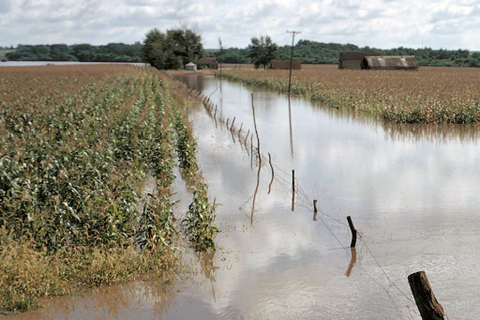Quick facts
- Floodwaters can introduce contaminants into farm fields, which can make produce unsafe to eat.
- Throw away produce that comes into direct contact with floodwaters.
- Wait at least 30-60 days before replanting flooded fields with vegetables. If heavy metal or high levels of contamination are suspected, wait at least 60 days.
In some years, Minnesota farms are faced with significant flooding damage. Flooding can be bad for crops for many reasons. Flooding can introduce chemical and microbial risks to fresh produce that can cause human illness if the produce is eaten.
Keep the guidelines below in mind when considering the safety of your produce after a flooding event.
Food safety risks associated with flooding
According to the FDA, flooding is the flowing or overflowing of a field with water outside a grower’s control. It is not just heavy rain falling and pooling around your plants, or a sprinkler left on overnight (this would be defined as pooling).
There are two types of risks associated with floodwaters:
- Human microbiological pathogens such as bacteria, viruses and parasites that can cause foodborne illness.
- Chemicals, heavy metals and petroleum products.
These biological and chemical contaminants, even if you cannot see them, cannot be safely removed from the produce by washing. This can make the produce unsafe for consumption, and the produce must be considered contaminated or adulterated under FDA regulations.
What to do with produce that has been touched by floodwaters
Because of the significant risk that floodwater carries, if the edible portion of produce comes into direct contact with floodwaters it needs to be discarded. This includes root vegetables in the soil, squash and melons with a hard rind.
For crops that are in or near flooded areas where water did not contact the edible portion of the crops, such as staked tomatoes or sweet corn, evaluate each situation and the risks.
You should ask:
- Did the water splash onto the edible portion of the crop?
- How far above the water was it?
Remember that floodwaters can have very high levels of heavy metals and pathogens, and even small amounts can contaminate produce. If in doubt, it is best to err on the side of caution and discard affected produce to avoid illness for your customers, and to avoid any foodborne illness that might be traced back to your farm.
Replanting vegetables in flooded fields
For replanting or harvesting items that grow after a flood event, you should base decisions on your own risk assessment and the extent of flooding. The FDA recommends waiting at least 30-60 days before replanting vegetables in flooded fields.
If you think the floodwater that was on the field could have contained heavy metals or high levels of contaminants, it is best to wait to replant for at least 60 days. An example of this would be if there is an animal operation just upstream from your farm. If the water was low risk in your estimation, and the crop you are growing is off the ground with a low risk of touching the soil, this situation might be lower risk. Unfortunately, there is no hard and fast rule since there are many things to consider when making that judgment.
One good option might be to plant the field with cover crops until the next growing season. For more information on planting suggestions, see Flooding in Vegetable Fields, Iowa State University.
A few other tips
Flooding can impact wells if the wellhead is submerged. If the wellhead was submerged on your property, test the well for generic E. coli, which will indicate fecal contamination.
Consider putting flags and place markers at the high-water lines on your fields so you can identify the areas where crops were in contact with floodwaters. This will help you identify which produce items have come in contact with the floodwaters.
Produce Safety Alliance: Food Safety for Flooded Fields. Colorado State University.
FDA Guidance for Industry: Evaluating the Safety of Flood-affected Food Crops for Human Consumption. Federal Department of Agriculture.
Reviewed in 2024


